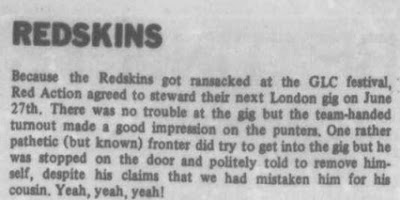The Redskins were one of the few avowedly revolutionary socialist bands in mid 1980s Britain. They also had some decent tunes as well as a very sharp look. Two members of the band were active in the Socialist Workers Party and their musical output reflected this, indeed their first and only album took its name from the SWP's defining tagline 'Neither Washington nor Moscow' (but International Socialism). The band played numerous benefit gigs, especially during the miners strike.
We might expect the party hierarchy to have been pleased at having such a band talking up its politics in songs and in the music press. But when the band were covered in Socialist Worker in September 1984 the tone was decidely lukewarm. After acknowledging their use 'to raise funds and fuel the spirit' Ed Warburton's article 'Powerful music, political pitfalls' goes on to warn that 'the dangers are great'. Some of the arguments are not particularly controversial - yes, the music press builds people up then knocks them down again, and 'the music business turns everything into a commodity. Rebellion is safely packaged'. The final sentence 'you can have revolutionary rock'n'roll but you can't be a revolutionary rock star' does though read a little bit like a direct warning to the band and a lot less than a glowing endorsement.

The negative tone was certainly picked up by many and there was an outpouring of support in the letters page of the paper. Paul McGinlay from Glasgow described the article as 'cynical, uneducated' and ' that 'The Redskins are the poison in the machine, and if you'd seen them you'd know that they'd go down rather than sell out'.
A Tyneside miner likewise called the article 'insulting and narrow-minded' and said 'I say all power to the Redskins and thank them for their Victory to the Miners gigs'.
'Ed Warburton's friend' came to his defence, claiming that he hadn't been slagging off the Redskins but making a broader point of critiquing those on the left 'who believe that red bands and stars spouting socialism in the NME are the shortcut to getting our message across. All that does is turn socialism into a fashion that the rock business can turn into last year's model and discard at a whim'.
A review of miners strike music in the paper shortly after does highlight the Redskins 'Keep on keeping on' single. Seemingly the band 'aren't to everyone's taste musically, but for sheer hard work, commitment and rock 'ard politics they can't be beat'.
The band split up in 1986. Over at
Moving the River I found the story announcing this from the NME with the headline 'A rock and roll socialist fantasy ends'. It reads a little like the kind of state sponsored 'apology' read out by prisoners on Chinese media with the band's Martin Bottomley bemoaning the band's drift away from 'the party and its collective discipline'. He did though make the point that 'socialists should not discount the possibilities that popular culture can present'.

The SWP's ambivalence about the band most associated with it had a number of sources I think. The first stemmed from the top down culture of the party. Essentially a small number of people did the writing and thinking for the party, the job of the thousands of other members was to distribute this by the main activity of selling the paper. Before social media and the internet, there was very little opportunity for people to put their own political views out there unless they started their own publication. People in the SWP who had their own platform independently of the party, such as a band or a zine, were always viewed with some suspicion.
But in the case of the Redskins there was perhaps a more specific issue. To lay claim to the skinhead identity as a socialist in the early 1980s was a bold move: a statement of intent to occupy a subcultural space that the far right thought belonged squarely to them. Inevitably this was going to get a violent response, and it did at on June 10 1984 at the Greater London Council's 'Jobs for a Change' festival in Jubilee Gardens on the South Bank. An estimated 150,000 went along to see The Smiths, Billy Bragg, Misty in Roots, Gil Scott-Heron and the Redskins. As the latter were playing a group of around 100 bonehead fascists stormed the front and attacked people around the stage. I was in the crowd and there was a lot of panic as most people ran to get away, despite the fascists being massively outnumbered. Later there was more fighting as the fascists regrouped and attacked the crowd at another stage where Hank Wangford was playing. I ended up with a motley crew of Red Action, punks and anarchists chasing nazis around the South Bank.

By this point the SWP, who had arguably been amongst those at the forefront of militant anti-fascism in the 1970s, were in no position to respond to such attacks even if they wanted to. It had actually recently expelled some of its most militant streetfighters for the offence of 'squadism' by which they meant putting too much focus on physically opposing fascists. Those expelled went on to form Red Action which was to be the backbone of Anti Fascist Action for at least the next 10 years. When The Redskins next played a London gig it was Red Action who provided the security. The experience of The Redskins showed that the SWP's position at the time of more or less ignoring the far right threat was untenable, not that they would ever acknowledge it. The SWP acted like nothing had happened on the South Bank and neither the event or the fascist attack fiasco were mentioned in the following week's Socialist Worker.


.jpg)






















